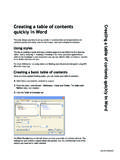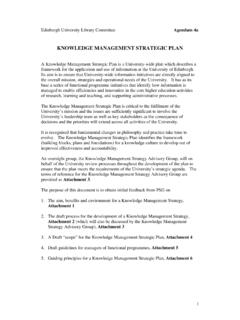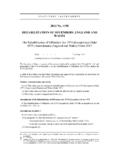Transcription of Creating lists and numbered headings in Word 2013
1 Information Services If you require this document in an alternative format, such as larger print, please email 3816-2014 Creating lists and numbered headings in Word 2013 Creating lists and numbered headings in Word 2013 If you have ever wrestled with numbering in Microsoft Word, you are not alone! Numbering, particularly for headings , can generate more frustration than almost any other feature. This note shows you how to customise numbered lists , and takes you through the easy way to create a numbering scheme for your headings .
2 Types of numbering Word has three main types of numbering: Fields Fields include page numbering, captions and footnotes, and are relatively robust. Simple lists Simple lists include bulleted and numbered lists . Multilevel lists Multilevel lists are hierarchical lists which can be applied to paragraphs or headings . Heading numbering is most often seen in technical and academic documents, and will have several levels, for example: 1 Heading Heading Heading Heading 2 Heading Heading Heading Heading Word can accommodate nine levels of numbering.
3 Each level can be associated with a different style, can be a different number format (such as 1,2,3; a,b,c; i ii,iii.), and can restart multiple times a recipe for disaster indeed. 2 IS skills Development Creating a simple list If all you need is a simple bulleted or numbered list, the Bullets and Numbering commands in the Paragraph group on the Home tab are usually enough. You can click on the down arrow at each command to choose a different bullet or number format from the library. There is also an option to define a new number format or bullet.
4 For bullets, you can choose a Symbol (change the font to Wingdings for a wide selection), use a Picture, or click on Font to change the colour and size. Restarting a numbered list If you are Creating multiple lists in a document, you may need to force a list to restart the numbering sequence. For example, if you haven t entered any text or other content between the lists , Word assumes you are continuing with the same list and will number accordingly. To restart the list, right-click in what is to be the first item and select Restart at 1.
5 You can also click on the AutoCorrect Options icon (if it is visible) and select Restart Numbering. Changing the indentation settings To quickly change the indentation setting for a single list, click in the list and on the Decrease Indent or Increase Indent options in the Paragraph group. This will not change the settings in other lists or for new lists . To set indents precisely, right-click in the list and select Adjust List Indents. Enter the values for the number position and text indent. To adjust the hanging indent, make sure Add tab stop at is selected and enter the same value as in Text indent.
6 lists you have already created will not change. Any lists you create after the amended one, however, will have your new settings. Changing the appearance of list text If you want to change how the text in a numbered or bulleted list appears to make it bold or italic, for example you can save time by using Word s styles rather than by manually formatting each list. If you don t know how to use styles, see the note: Formatting with styles in Word in our Documents Catalogue at Tip: If the numbering refuses to restart, try this.
7 Right-click on the number and select Set Numbering Value. Choose Start new list and set the value to 1. (You can also click on the down arrow at Numbering in the Paragraph group and select Set Numbering Value.) IS skills Development 3 When you create a list using the Bullets and Numbering commands, Word uses a style called List Paragraph to format the text. Click in the list, then, on the Home tab, click on the dialog box launcher in the Styles group to open the Styles pane. Scroll through the pane until you see the style List Paragraph (you may need to scroll to the bottom).
8 Click on Show Preview to see how the formatting looks when applied. To change the formatting, move your cursor to the style name in the Styles pane, click the down arrow and select Modify. From the Modify Style dialog box you can change the font face, size, and colour. The changes will be applied to all lists , new and existing. You can also change the space between list items. In Modify Style, click Format and select Paragraph, deselect Don t add space between paragraphs of the same style, then adjust the Spacing After setting. Do not use the Indentation settings in the Paragraph dialog box to try to change the positioning of the number or bullet Word ignores these.
9 Instead, right-click in the list and select Adjust List Indents as in Changing the indentation settings on page 2. This will not change the indent settings for existing lists , but will for new lists . Using list bullet and list number styles Another way to create lists is to use Word s List Bullet and List Number paragraph styles. You can choose from a variety of predefined indentation settings, and like the List Paragraph style, you can modify the font formatting. In the Styles group on the Home tab, click on the dialog box launcher to open the Styles pane.
10 List styles do not display by default, so click on Options, and in Select styles to show, choose All styles. Scroll down till you come to the styles for bullets and numbers. Each one has a different indent setting. Note: The Font options in Modify Style will change the formatting of the text and the number; for example, choosing bold will make the number bold as well. If you don t want the number formatted in the same way as the text, click in a list, then, on the Home tab, click on the down arrow at the Numbering command in the Paragraph group and select Define New Number Format.









